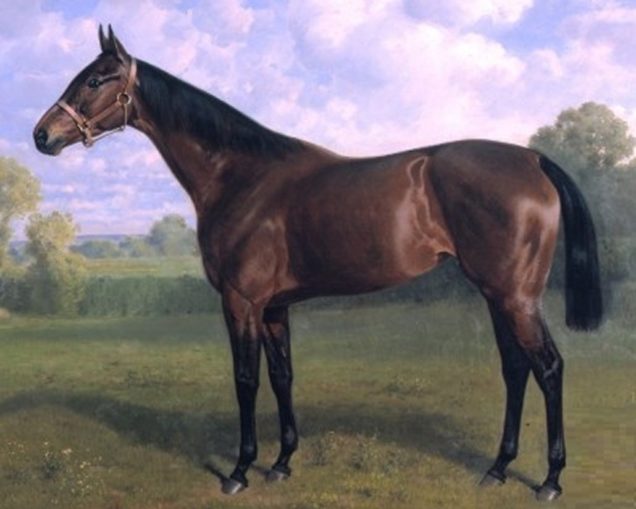Firstly, I hoped you thoroughly enjoyed my first few articles covering the two key national hunt festivals in the UK. Now that the dust has settled on the recent Aintree Grand National and a belated congratulations to @Jesus for tipping and backing the winner, Corrach Rambler, our attention now turns to the UK flat racing season. But before doing so, please permit me the indulgence of a short obituary for Hill Sixteen, who tragically lost his life in the aforementioned race.
Hill Sixteen (Foaled 4th May 2013 – Died 15th April 2023)
Hill Sixteen was foaled at Boardsmill Stud, County Meath, Ireland and subsequently named after the famous terrace at the Railway End of Croke Park, Dublin. After winning his first point-to-point race at Dromohane in 2018, he was bought by the late Trevor Hemmings (former owner of Blackpool Tower and of three Grand National winners) and sent to Sue Smith’s yard in Bingley, West Yorkshire. Hill Sixteen, a strapping bay horse, clearly had natural ability but although he won two races and was placed in five over the next couple of seasons, he did seem to have his own mind about the game and proved difficult to train. However, as is often the case, a change of ownership and a change of scenery with a new training establishment in late 2020, seemed to bring the old boy to life. Hill Sixteen won on his first two races for the new yard. Regrettably, he then seemed to lose his way again. He was pulled up in three of his next four starts, and his owners decided it was time for Hill Sixteen to move on again.
Hill Sixteen’s final home would be Sandy Thomson’s yard at Lambden, near Kelso. Thomson, a former international rugby player, and an astute trainer of staying types, quickly realised that marathon trips would be the key to success for his latest acquisition. After a bold show in the 2022 Scottish Grand National, Hill Sixteen, later that year, he was aimed at the Beecher Chase run over one circuit of Aintree’s Grand National fences, where he finished a gallant 7th. Thomson immediately declared that his horse would return in 2023 for the National itself and be fit and ready to do himself justice. After a 122 days break from racing and following a wind operation, the horse returned to his local track, Kelso, for a prep race, which served to blow the cobwebs away.
In a pre-race interview for the Grand National, Hill Sixteen’s trainer stated that he was delighted with the rain softened ground and that his charge was certainly capable of pulling off a surprise especially, as he likes the Aintree track and the fences. As millions gathered in front of their TV sets, the race was delayed after a large number of animal rights’ protestors breached the security cordon around the Liverpool venue. Eventually, the race started at 5.27pm (instead of 5.15pm). Hill Sixteen, ridden by Ryan Mania, the winning rider a decade ago, was tucked in behind a wall of horses. Twenty-seven seconds later the horse fell for the first time in his twenty-seven-race career. The horse lay stricken on the landing side of the fence. He immediately received veterinary attention and the whole field omitted the fence on their second lap of the course. Sadly, Hill Sixteen broke his neck in the fall. A fatal injury.
In a post-race interview, Thomson blamed the “ignorant” protestors for delaying the race. He claimed his horse became “hyper” at the start. I have seen this happen to many horses on the big occasion. So, we will never know if the near fifteen-minute delay did contribute in any way to the horse getting overly excited before the race. Either way, it was a horrible thing to witness and certainly cast a giant shadow over what should have been a memorable day for the punters and owners alike.
RIP Hill Sixteen. You will be always be missed.
And They’re Off…
Traditionally, the Lincoln Handicap, run over the straight mile at Doncaster in late March, has acted as the curtain raiser to the British turf racing flat season. This year’s race was won by the topically named Migration, a horse that I believe is destined to go onto even greater things, judging by the manner of his victory.
The flat racing calendar for the month of April features a number of races, or trials, some of which provide a useful pointer to the winners of the forthcoming British Classics. The Classics are five long-standing Group 1 horse races that are designed to test the speed and stamina of a thoroughbred horse. The races are restricted to three-year-olds and represent the pinnacle of achievement for racehorses against their own age group. As such, victory in any British Classic marks a horse as amongst the very best of a generation.
The five British Classics are the 2000 Guineas and 1000 Guineas, both run on the Rowley Mile at Newmarket in later April or early May, the Derby and Oaks both run over one and a half miles at Epsom in June and the St Leger, run over a mile and three quarters at Doncaster in September.
Before moving on to the first of the Classic races held at Newmarket, it’s worth mentioning that victory in three of the series (a rare feat known as the Triple Crown) marks a horse out as truly exceptional. The last horse to achieve the Triple Crown was Nijinsky back in 1970 and Oh So Sharp managed to replicate the feat by winning the fillies’ Triple Crown (1000 Guineas, Oaks and St Leger) in 1985. It is also theoretically possible for a filly to win all five Classics. In 1902, Sceptre went the closest to doing so. A bruised foot put pay to her chances in the Derby, where she finished a gallant fourth behind Ard Patrick.

Emil Adam, Public domain, via Wikimedia Commons
2000 Guineas
This race was first run on 18 April 1809 and acquired its name from the original prize funds, a guinea being 21 shillings or £1.05 in “new money”. By comparison the prize fund in 2023 will exceed £0.5m which taking into account inflation over the years represents almost a doubling of the original purse for the race.
Newmarket hosts the first two Classic races on the Rowley Mile course, named after Charles II’s favourite stallion, Old Rowley. The grass has been untouched since it was last ploughed on the orders of Oliver Cromwell. The track itself is generally flat and wide and consists of two key features. The so-called “Bushes”, which are situated at the two-furlong marker. Then comes the “Dip” which signals a downhill section followed by a slight incline to the winning post. Quite often this sudden change in gradients can unbalance a horse and put pay to its chances. Course form, is therefore an important factor to consider for all Newmarket races.

Reflecting on the 2000 Guineas race itself, I have a hazy memory of watching Nijinsky winning the 2000 Guineas, back in 1970, ridden by the then housewives’ favourite, Lester Piggott and priced at very skinny 4/7 odds. Well at least the shopping money was safe, I suppose. But it was the following year’s winner, Brigadier Gerard, which really brought the race to my attention. The Brigadier, was trained by Major Dick Hern (former trainer to the Queen Elizabeth II) and ridden in all his races by Joe Mercer. A beautifully balanced bay colt, named after Sir Arthur Conan Doyle’s swashbuckling hero, Brigadier Gerard, won seventeen of his eighteen races and was rated as the best trained horse in Britain in the 20th century.
In 1971, despite his outstanding form, the horse wasn’t even made favourite for the 2000 Guineas. That honour went to another racing great, Mill Reef, but he was to be no match for Brigadier Gerard, who swept past the entire field at the three-furlong marker before and strode away to win by three lengths.
From thereon in, the Guineas was high up on the list of horseraces I would look forward to seeing each year. Winter nights would be spent studying the form book after which I’d place a few ante-post bets on horses I felt were capable of making a bold show in the race the following Spring.

Looking back through my racing diaries, I was slightly shocked to discover, that despite visiting Newmarket racecourse, the home of horse racing, several times, I’d only ever turned up to see the 2000 Guineas once and that was precisely twenty years ago. But that day, 1st May 1993, will live long in the memory.
Zafonic
In 1992, a horse called Zafonic, was crowned the best two-year old horse in Europe after spread-eagling the fields in two Group 1 races, including the Dewhirst Stakes at Newmarket, with his blistering turn of foot. I’d backed him ante-post despite him being a short-priced favourite for the following year’s 2000 Guineas. But for some, the doubts began to creep in when he lost by a short-head in his seasonal return at Deauville priced at 1/10. The defeat put an end to his unbeaten record and for a short time, his odds drifted to 9/4, so I struck a £200 bet to win on the nose with my local bookie.
On Guineas Day 1993, the weather in and around Newmarket was atrocious. Zafonic’s plane, which was due to land on the racecourse had to be diverted to Cambridge Airport because of the thick fog. Would this unsettle the horse? The market didn’t think so, as his odds shortened and he was eventually sent off slight odds-on favourite.
When you are watching from the Newmarket stands, the Rowley Mile seems to go on beyond the horizon. It’s a vast expanse of land. Even through a pair of binoculars the horses still appear to have been miniaturised.
Zafonic was drawn over on the far side in stall number 5. I looked at my watch it was five minutes after post time. The sky thickened. At 3.45pm the course commentator called the immortal words “And They’re Off” which was greeted by a huge roar from the stands. Peering through my binoculars, I could just about make out my horse’s distinctive colours; the green silks with a pink sash worn by his jockey, Pat Eddery, who appeared to be sitting motionless. At the three-furlong marker, Zafonic lit-up the turbo boosters and I swear at that very second a crash of thunder rumbled across the Newmarket Heath. The horse quickened into the lead and Eddery didn’t move a muscle, as they cruised to an ever extending three and a half lengths, posting a new track record (1m 35.32s). A quick shake of my brother’s hand followed and we scurried under the stands to greet our hero’s return to the winning enclosure. Then it was off to the bar for our customary glass of celebratory champagne. A follow-up visit to the headquarters of racing surely cannot be too far away.
As a postscript to the race, Zafonic’s owner, Sheikh Khalid Abdullah, would see his colours to the fore again in the 2011 renewal, carried this time by one of the greatest horses in history, the mighty Frankel. Frankel won all fourteen of his races, earning almost £3m in prize money, and his performance in the 2000 Guineas has been described as “one of the greatest displays on a British racecourse”.

By Sjp22 License: CC BY-SA 4.0
The 2023 Renewal
As mentioned previously, the 2000 Guineas is served by several trial races most notably the Craven Stakes and the Greenham Stakes, both run in April at Newmarket and Newbury respectively. Although these trials take place over a slightly shorter distance (7 furlongs) they do provide further visual evidence of a horse’s capability of staying the mile trip of the Guineas itself. Indestructible won this year’s Newmarket trial, so I can imagine he might be popular with our own occasional punter @Captain Black. Isaac Shelby tasted victory in the Newbury trial though this was due in part to Frankie Dettori’s customary dismount occurring immediately after leaving the starting stalls on race favourite, Chaldean, rather than minutes later in the winner’s enclosure. Although the aforementioned horses feature prominently in the betting for the big race, due off at 3.40pm on Saturday 6 May, I cannot see any of them troubling the judge. The betting market is currently dominated by two horses trained in Ireland by the genius, Aiden O’Brien, Little Big Bear and Auguste Rodin. O’Brien has trained the winner of the race ten times since 1998 and his horses are usually there or there abouts. Little Big Bear is the pacier of the two, whilst Auguste Rodin has abundant stamina on his side. I really hope the latter horse can win the 2000 Guineas, as this will set him up for a crack at the Triple Crown. Finally, in Coronation year I ought to give a mention to the King’s horse, Slipofthepen, who is currently priced at around 20/1. Winning the race would undoubtedly cap a momentous day for his Royal connections.
1000 Guineas
The 1000 Guineas is the second of Britain’s five Classic races, and is the first major test for three-year old fillies. The race was first run on 28 April 1814, five years after the inaugural running of the 2000 Guineas. Like its near namesake it is also run on the Rowley Mile at Newmarket over a distance of one mile.
Although it’s a race, I have never had the privilege to watch from the Newmarket stands, there is one particular day that still remains firmly etched in my memory. That day is Sunday 7 May 1995, when the 1000 Guineas became the first ever classic to be run on British soil on a Sunday (with betting). It was just three years earlier, back in July 1992, when Doncaster became the first racecourse in the UK to host a Sunday meeting. At that time, it was still illegal to charge entry to any sporting event held on a Sunday. As a work-around, the Government and the Horseracing Industry agreed to allow those turning up for this historic occasion to enter the racecourse by purchasing a £5 ticket to see the band of the Irish Guards. Cash betting on a Sunday was also illegal, so this meant that there were no on-course bookmakers. Instead, you could either have a bet the previous day or via a credit account on the day assuming you had one. How times have changed. Oh, and the next time you have a punt on a Sunday, you might want to raise a glass to the late Honourable Member for Livingston, Mr Robin Cook MP, who was the architect of a bill permitting racing on the Sabbath. Cook was a great ally to the racing industry and even provided a tipping column for his local newspaper.

The winner of the 1000 Guineas race in 1995 was Harayir, a bay filly, trained by the aforementioned Major Dick Hern. This was to be Hern’s fourteenth and final Classic winner. Hern was seriously injured in a hunting accident back in 1984, but managed to continue his highly successful training career with the aid of a wheelchair. In 1988, he was controversially sacked as lead trainer for Queen Elizabeth II, when recovering from heart surgery at the time. Hern died in 2002 aged 81. Harayir’s career only lasted from June 1994 to October 1995. Over that short period, she ran thirteen times and won six of her races. Willie Carson rode her in twelve of her races but chose to ride Aqaarid, for John Dunlop in the 1000 Guineas. This proved a costly mistake with the last-minute substitute, Richard Hills, guiding the filly to a one and a half lengths victory. A disgruntled Carson finished runner-up in the race.
The 2023 Renewal
This year’s 1000 Guineas will be held on Sunday 7th May, and the betting suggests it is quite an open race. The race is served by several key trial races, which, include the Nell Gwyn Stakes run at Newmarket’s Craven meeting in April and the Fred Darling Stakes run at Newbury. Though for some horses it is their first race of the season. Mama’s Girl produced a devastating last to first burst of speed to win her trial at Newmarket and I wouldn’t put anyone off thinking about taking the 7/1 price on her. The winner of the Newbury trial was Remarque, trained by the very capable Ralph Beckett, and she looks to be something special and particularly good value at a best priced 6/1. But with Meditate heading the betting throughout the winter, priced at around 3/1, I think that there is every possibility that the Master of Ballydoyle, Aiden O’Brien will pull off a Guineas double for a remarkable fifth time in his illustrious training career.
Next time, we are off to Epsom for The Derby and The Oaks, the next two legs in the British Horseracing Classics series. We will also have a brief look back at the results of this year’s 1000 and 2000 Guineas to see if they can offer any pointers towards contenders for the forthcoming Epsom classics.
Sources:
British Classic Races – Wikiwand
All About The Rowley Mile | The Guineas Festival |The Jockey Club
Zafonic – Racing (juddmonte.com)
Frankel (horse) – Wikiwand
1000 Guineas Stakes – Wikipedia
© Nautilus 2023



